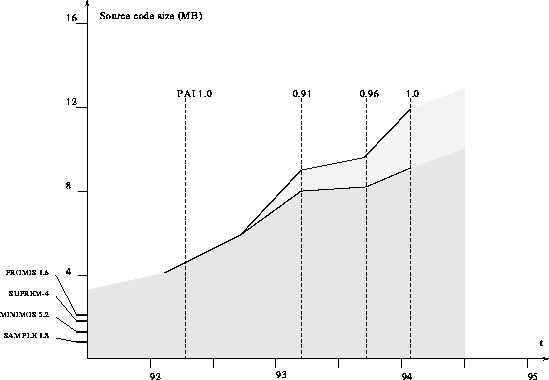1.3 <i>VISTA</i>





Next: 2 The Application-Framework Architecture
Up: 1 Introduction and Overview
Previous: 1.2 Existing TCAD Systems
It will be shown that most of the mentioned TCAD systems do not
properly address important software issues that retard the progress of
TCAD. These software-related issues (which will be investigated in
the next chapter) have been the motivation to design and implement the
Viennese Integrated System for Technology CAD Applications
(VISTA).
The project started in 1990 and has been carried out at the Institute
for Microelectronics, Technical University Vienna, in
cooperation with academic and industrial partners in Europe, Japan,
and USA. During the past 4 years, VISTA has almost
reached industrial maturity, although the major aim is by far beyond
simple
practical utility. The key design paradigm of VISTA is the
conception of the TCAD situation as a continuous
application engineering process
rather than a static problem situation.
So far, the scope of VISTA has been restricted to ``vertical''
Technology CAD, that is to process, device, and interconnect
simulation which focus on technology modeling and vertical device
design rather than horizontal (mask) layout. However, most parts of
VISTA are designed and implemented in such a general way that they
are applicable and extensible to may other CAD areas as well.

Figure 1.2: Source code size of VISTA. The dark gray
shaded area denotes the amount of manually created coded, the light
gray area stands for automatically created code. Bold lines indicate
actually measured values, all other values are based on
estimations.
The emphasis on software aspects is simply (but not solely) motivated
by the complexity of the system.
Figure 1.2 shows the source code size development of VISTA. In
this figure, the size of VISTA does not include the integrated
TCAD applications (the simulators).
The VISTA software release dates are marked with dashed lines.
For comparison, the respective code sizes of some classical point
tools are marked on the ordinate axis.
A saturation of the ongoing development and extension of VISTA
is currently not in sight. Considerable effort has been spent to
counteract the complexity of the system by thorough
architectural choices. Most of these choices and some
critical software components are subject of this work.





Next: 2 The Application-Framework Architecture
Up: 1 Introduction and Overview
Previous: 1.2 Existing TCAD Systems
Martin Stiftinger
Thu Oct 13 13:51:43 MET 1994





